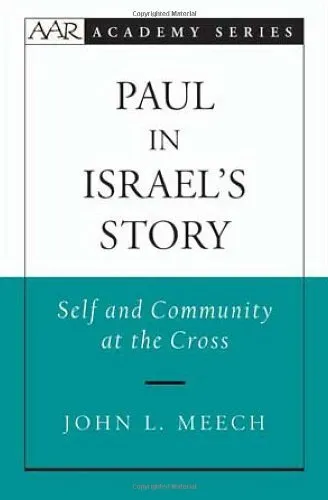This article was originally part of The Paul Page, a site dedicated to academic study of the apostle, with special focus on the work of N.T. Wright.

John L. Meech (Oxford University Press), 2006, 192 pp.
Paul in Israel’s Story: Self and Community at the Cross from the AAR Academy Series is an impressive interdisciplinary work which moves nearly seamlessly through the fields of biblical theology, systematic theology, and philosophy. Although properly speaking it perhaps falls into the category of what Pamela Eisenbaum has characterized as a “neotraditionalist” reading of Paul (meaning the traditional approach considered in light of the new perspective), nevertheless Meech’s work demonstrates a nuanced systematic reading of Paul which arguably articulates what many biblical scholars have (in my opinion) not as successfully envisioned — a hypothetical “post-new perspective perspective.” This is in part precisely because Meech sidesteps focused biblical debate in a larger philosophical quest to address the postmodern problem of the self as articulated by Paul Ricoeur.
Specifically, although not uniquely, Meech begins by lessening the tension between Luther and the new perspective by reading Luther’s doctrine of justification against the background of the eschatological community as constituted in Christ (cf. pp. 12,13). In proceeding to lay out a biblical interpretation of Paul’s self-understanding, Meech chooses as his principal dialogue partners James D.G. Dunn, N.T. Wright, Terence Donaldson, and Stephen Westerholm. Theologically Meechconsiders himself a Bultmannian (cf. p. 5), although he strongly argues that a critical reappraisal ofBultmann is essential.
Specifically, while following Bultmann in asserting that a transcendent encounter with the risen Lord can be articulated in phenomenological terms (cf. p. 46), Meech rejects Bultmann’s eschatology as being empty of content, preferring instead Jürgen Moltmann’s account of the community of the living and dead in Christ. More to the point, and this is what occupies most of Meech’s book, Bultmann’sattempt to move directly from Paul’s interpretative horizon to our own by means of his program of demythologization is supplanted by a series of detours as articulated by Paul Ricoeur in addressing the problem of the self as other. Meech further qualifies Ricoeur’s work by emphasizing the self in the context of a community. Writing of Paul’s shift in his self-understanding, Meech draws together his biblical, theological, and philosophical arguments:
Paul fails to recognize his community with Jesus because of a misdirection of the community’s aim in Paul and others. In what Paul later articulates as an encounter with the risen Christ, he is confronted by a silent suffering other who cannot be articulated in his community’s story. When he retells the community’s story so that Jesus can appear as a living body like himself, Paul can finally represent Christ’s suffering as his own (“I bear on my body the brandmarks of Jesus,” Gal. 6:17). In this reconfigured story, a more original community of persons is disclosed in which each person is a living body. Paul shifts from one who confidently addresses his world to one who is addressed by a new referent — the crucified and risen Christ. That the referent is new does not mean that Paul’s reconfiguration created it. Rather, in retrospect he can say that his community always bore witness to Christ and that the community is continuous in its embrace of this other despite its former misdirection. Paul narrates this concordant discordance as the community’s dying and rising with Christ and locates his own dying and rising in the community (p. 132).
Those who, like myself, remain somewhat less than enthusiastic about Luther and Bultmann should nevertheless be able to appreciate Meech’s correctives vis-à-vis Moltmann, Ricoeur, and an emphasis on community in articulating an approach to Paul’s self-understanding. Regardless of whether this approach proves compelling in the long run, nevertheless Meech’s thoughtful book should be considered seriously as a welcome and long overdue initial systematic treatment of key Pauline themes in the newly reconfigured landscape of Pauline biblical studies and contemporary philosophical discourse. It will be very interesting to see how future works explore this otherwise uncharted territory.





